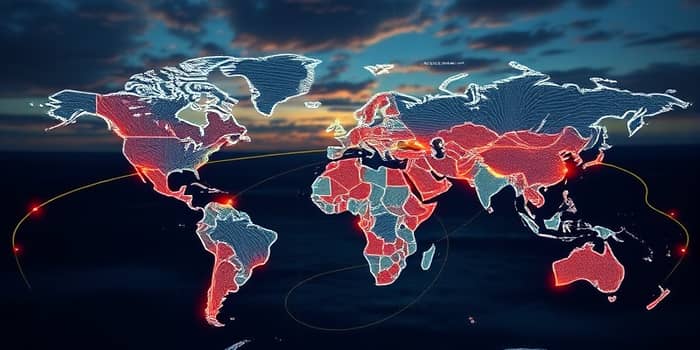
In the first half of 2025, global trade expanded by $300 billion, propelled more by price increases over real volume than by a surge in shipments. While headline figures suggest resilience, underlying merchandise volumes show signs of strain, with projections pointing to a potential -0.2% contraction in 2025. Slowing GDP growth—from 2.8% in 2024 to an expected 2.2% in 2025—adds to the complexity, underscoring the challenge of interpreting nominal gains in a high-price environment.
The early months of 2025 delivered a mixed bag of outcomes. North America emerged as the biggest drag, expected to shave off 1.7 percentage points from global growth. By contrast, developed economies regained momentum: US imports leapt by 14% and EU exports rose by 6% in H1. Asia’s contribution to global trade growth narrowed to just 0.6 percentage points, with China facing stagnating demand. Amid these trends, service trade stood out, growing 9% over the past year, though it, too, is set to slow from 6.8% growth in 2024 to 4.0% in 2025.
Crucially, the disconnect between value and volume reveals that many countries are paying more, not necessarily trading more. This divergence raises questions about sustainability once price pressures ease or reverse.
Renewed US ‘reciprocal tariffs’ on a broad array of imports have injected fresh volatility into global markets. Importers rushed to front-load shipments before new levies took effect, driving short-term spikes in industrial supplies and pharmaceuticals. Yet the long-term impact looms large: models estimate merchandise trade could shrink as much as -1.5% if protectionist measures intensify.
Policy uncertainty itself has become a market stressor. Firms hesitate to invest or expand supply chains amid the threat of sudden tariff escalations. This environment fosters tariff-driven trade distortions that can erode confidence and stall recovery.
Each region tells a unique story in 2025’s shifting sands. North America grapples with a widened US trade deficit—$71.5 billion in May, up 18.7% from April—while Europe’s export rebound signals stronger external demand. Asia’s trade expansion has slowed, and China’s import volumes declined, especially in high-tech components. Africa bucks global trends, with exports up 5% and intra-regional trade surging 16%. Least developed countries (LDCs) stand to benefit from trade diversion, with projected export volume growth of 4.8%.
This regional mosaic underscores both opportunity and fragility. While some areas harness new alliances, others face the headwinds of policy shifts and weak demand.
In tandem with goods trade, the digital economy has accelerated, growing 9% over the last four quarters. Yet this robust expansion masks a stark concentration: the top five digital multinationals now control 48% of global digital sales, up from 21% in 2017. Generative AI platforms, cloud services, and e-commerce giants dominate high-value segments, prompting competition authorities to act—cases worldwide rose from 14 in 2020 to 153 in 2025.
This consolidation has sparked debates about consumer choice, innovation, and data governance. Enforcement, however, remains uneven outside OECD jurisdictions, raising the specter of digital market dominance by Big Tech stifling nascent competitors in emerging economies.
Amid uncertainty, companies are reconfiguring supply chains to bolster resilience. Regional hubs and new trade blocs emerge as alternatives to decades-old global networks. Some nations pursue ‘friend-shoring’ agreements, while others invest in domestic capacity for critical goods like semiconductors and rare earths.
Key strategies gaining traction include:
By adopting resilience through regional alliances, firms hope to insulate operations from geopolitical jolts and tariff whiplash.
Volatility in commodity markets has remained high. Rising crude oil prices bolstered Canadian exports, while metals and agricultural goods responded sharply to inventory and policy signals. Strategic sectors such as electric vehicles, pharmaceuticals, and renewable technology components have seen supply chains reoriented for autonomy and security.
Governments in the US and EU are incentivizing onshore production, aiming to reduce dependence on external suppliers. These initiatives, part of a broader supply chain reconfiguration in strategic sectors, may reshape global patterns for years to come.
Looking to 2026, analysts face divergent forecasts. The WTO’s late-2024 outlook anticipates a -0.2% contraction in merchandise trade, while the OECD maintains a 2.9% global growth forecast. Should tariff tensions flare or the US–China rivalry deepen, downside risks could dominate.
Key uncertainties include:
These factors underscore the fragmentation of global supply chains and the potential emergence of ‘slowbalization’—a prolonged phase of muted trade growth.
As stakeholders chart the course forward, balancing risk and opportunity is paramount. Diversification, policy coherence, and strategic investment in resilient networks will determine whether global trade can overcome its current volatility. While services trade as a growth engine may cushion goods-market weaknesses, enduring recovery hinges on reducing uncertainty and fostering cooperative frameworks. At this crossroads, adaptability and foresight will define the next chapter in the shifting sands of global trade.
References













